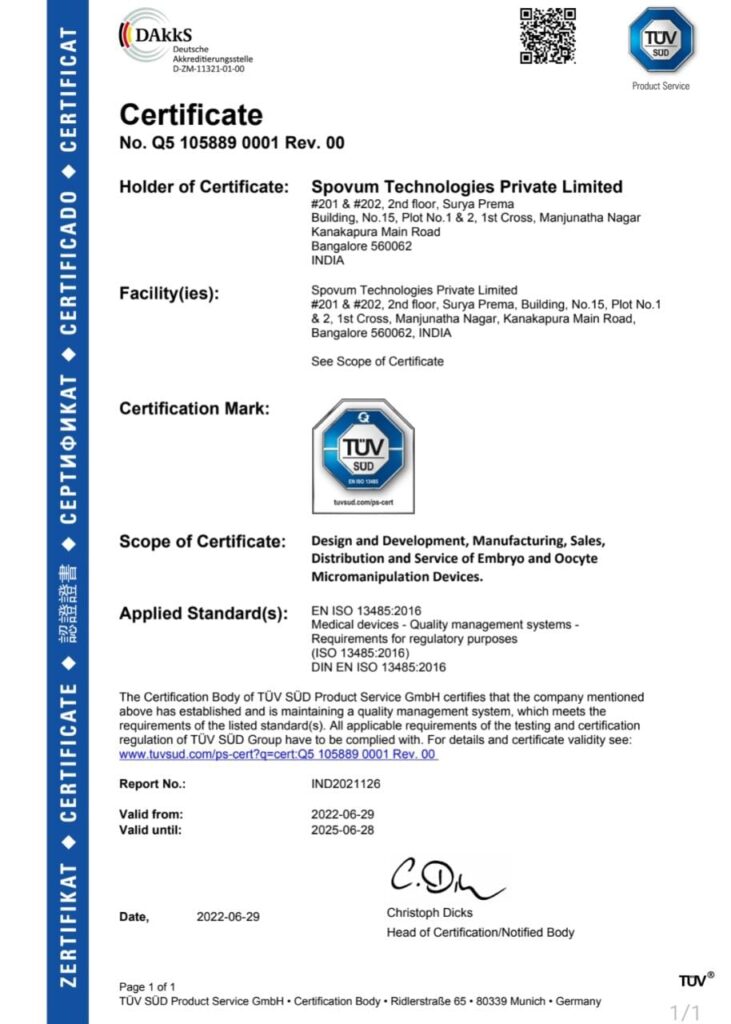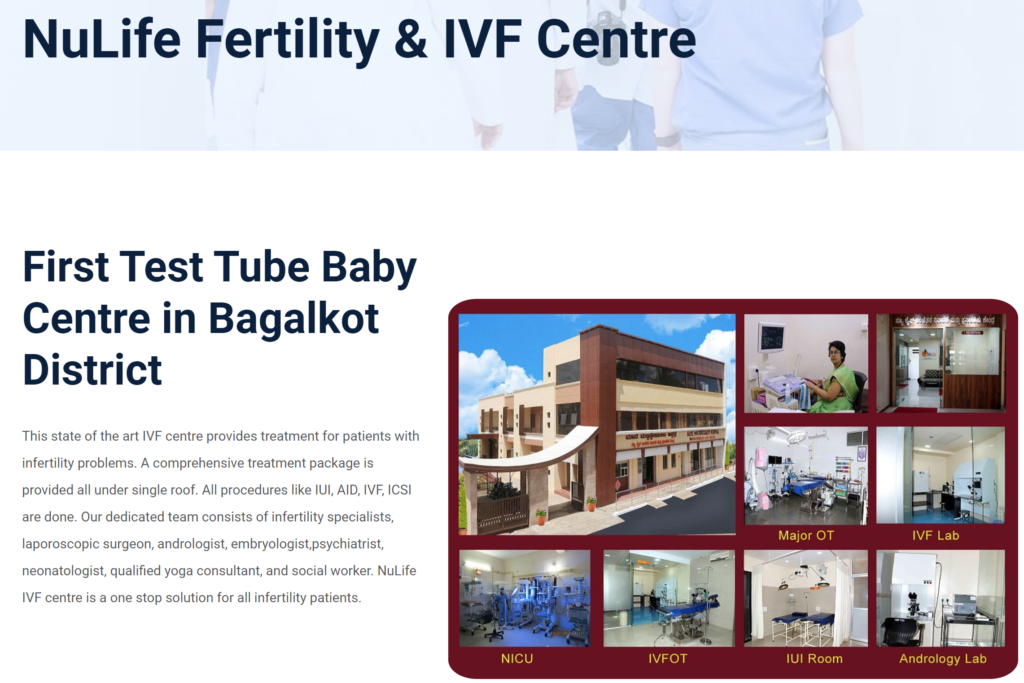Embryo Development
The product of fertilization is an embryo. The first stage is the one-cell embryo with a diploid number of chromosomes. The embryo undergoes a series of cell divisions, for few days to form a hollow sphere of cells known as blastocyst. [1]
Day-1, 2PN stage, in this stage, the embryo contains two polar bodies and two pronuclei with small nucleoli. One of the pronuclei contains genetic information from the egg and the other from the sperm. The pronuclei are usually checked between 16-18 hours after the sperm injection. [2]
The one cell embryo undergoes a series of cleavage divisions, progressing through 2-cell, 4-cell, 8-cell and 16-cell stages. The cells in cleavage stage embryos are known as blastomeres. Early on, cleavage divisions occur quite synchronously. In other words, both blastomeres in a two-cell undergo mitosis and cytokinesis almost simultaneously. Hence, due to these reasons, the embryos are most commonly observed at two, four and eight-cell stages. Embryos with an odd number of cells (e.g. 3,5,7) are less commonly observed, simply because those states last for a relatively short time. [1]
After the development of 8-cell embryo, the blastomere begins to form tight junctions with one another, leading to deformation of their round shape and formation of a mulberry-shaped mass of cells called a morula. This change in shape of the embryo is called compaction. It is difficult to count the cells in a morula, the embryo shown here probably has between 16 to 32 cells. [1 and 3]
Junctional complexes formed between the blastomeres gives the embryo outside and inside. The outer cells of the embryo express variety of membrane transport molecules, including sodium pumps, which results in an accumulation of fluid inside the embryo, which signals the formation of the blastocyst.
A blastocyst is composed of a hollow sphere of trophoblast cells, inside of which is a small cluster of cells called the inner cell mass. Trophoblast goes on to contribute to fetal membrane systems, while the inner cell mass is destined largely to become the embryo and fetus. Eventually, the stretched zona pellucida develops a crack and the blastocyst escapes by a process called hatching. This leaves an empty zona pellucida and a zona-free or hatched blastocyst lying in the lumen of the uterus. [1]
Embryo assessment
The most important morphological parameters to asses in the laboratory are blastomere appearance, fragmentation, and multinucleation. Those with equal blastomeres, minimal cytoplasmic fragmentation, and few multinucleated cells show a better prospect of implantation. [4]
The relative blastomere size in the embryo is dependent on both the cleavage stage and the regularity of each cleavage division. [3]
The fragmentation of the cytoplasm is therefore defined as the presence of anucleate structures of blastomeric origins. The degree of fragmentation is most often expressed as the percentage of the total cytoplasmic volume. The relative degree of fragmentation is defined as mild (<10%), moderate (10-25%) and severe (>25%). High degree of fragmentation correlates negatively with implantation and pregnancy rates, while the presence of minor amounts of fragmentation has no negative impact. [3]
The nucleation status is defined as the presence or absence of nuclei in the blastomeres of the cleavage stage embryo. Nucleation status of each blastomere in the embryo is evaluated as a single nucleus per blastomere, no nuclei visible or multinucleation. [3]. Multinucleation arises due to karyokinesis in the absence of cytokinesis with subsequent arrest of the blastomere or the entire embryo. Multinucleation may also be caused by partial fragmentation of nuclei or by defective migration at mitotic anaphase. [4] Multinucleation is predictive of a decreased implantation potential and are associated with an increased level of chromosomal abnormalities and increased risk of spontaneous abortion.
2PN embryo
The human oocyte arrested in the second meiotic division (M-II), usually characterized by the presence of a first polar body. The entry or injection of the sperm into the oocyte completes the second meiotic division. The second polar body containing the chromatids from one haploid chromosome set is extruded, and the female pronucleus is formed. During this process, the ooplasm rotates in a periodical way and in parallel the sperm chromatin decondenses. The sperm cell also delivers the centriole that has a leading role in further development and control of microtubules that are important for the symmetry of the developing embryo. These microtubules pull the haploid female pronucleus towards the male pronucleus. Both pronuclei finally migrate to the center of the cell and align. The G1 phase starts approximately 2-3 hr after sperm entry and pronuclei appear after 4-6 hr. The process is complete 18-22 hr after sperm entry or injection. [5]
Cleavage stage embryos
Embryos in cleavage stage range from the 2-cell stage to the compacted morula composed of 8-16 cells. Good quality embryos must exhibit appropriate kinetics and synchrony of division. In normal-developing embryos, cell division occurs every 18-20 h. Embryos diving either too slow or too fast may have metabolic and/or chromosomal defects. The blastomeres dividing in exact synchrony produces only 2, 4 or 8 cell embryos. Asynchronous developments lead to the formation of 3, 5, 6, 7 or 9 cell embryos. [3]
Mitosis in blastomeres should produce two equally sized daughter cells. When the division is asymmetric, one of the blastomeres of the next generation will inherit less than the amount of cytoplasm of parent blastomere, leading to a defective lineage in the embryo. After two cleavages, the zygote becomes a 4-cell embryo, where the 4-cells are normally arranged in a tetrahedron in the spherical space provided by the ZP. Blastomeres located close to a single, spatial plane produced by an incorrect orientation of division axes will lead to altered embryo polarity. [3]
After the embryo reaches the 8-cell stage, the blastomeres begin to show an increase in cell-cell adherence due to the spread of intercellular junctions. This is the start of compaction. The process of compaction advances during the next division until the boundaries between the cells are barely detectable. If some of the blastomeres are excluded from this compaction process, the embryo may have a reduced potential for becoming a normal blastocyst. [3]
Blastocyst
The blastocyst consists of cells forming an outer trophectoderm (TE/trophoblast) layer, an inner cell mass (ICM, embryoblast) and a blastocoel (fluid-filled cavity). The ICM forms an inner layer of larger cells also called as “embryoblast” which are the cluster of cells located and attached on one wall of the outer trophoblast layer. In week 2 of embryo development, ICM differentiates into two distinct layers the epiblast and hypoblast. ICM is the source of true embryonic stem cells capable of forming all cell types within the embryo. [7]
The trophectoderm (TE) outer layer of smaller cells is also called the “trophoblast” epithelium. The key function is for the transport of sodium (Na+) and chloride (Cl-) ions through this layer into the blastocoel. In week 2 this layer will differentiate into two distinct trophoblast layers the syncytiotrophoblast and cytotrophoblast cells and are key to implantation and early placentation. [7]
Blastocyst Hatching
As the fluid and number of cells inside the blastocyst increase its progressively causes enlargement of the blastocyst and its cavity with a consequent progressive thinning of the zona pellucida (ZP). Finally, the blastocyst breaks free of the ZP through a process called hatching.
Cytoplasmic Anomalies
The cytoplasm of cleaving embryos is normally pale, and clear or finely granular in appearance. Cytoplasmic anomalies, such as cytoplasmic granularity, cytoplasmic pitting and the presence of vacuoles, occur occasionally.
Cytoplasmic pitting is characterized by the presence of numerous small pits with an approximate diameter of 1.5 µm on the surface of the cytoplasm. The cytoplasm of blastomeres may be excessively darkened with centralized granularity, where these kinds of embryos have reduced implantation potential or can undergo degeneration.
Cytoplasmic vacuolization varies in size and number. Vacuoles are membrane-bound cytoplasmic inclusions filled with fluid that are virtually identical with the perivitelline fluid. Extensive vacuolization is always considered as detrimental. [6]
- http://www.vivo.colostate.edu/hbooks/pathphys/reprod/fert/cleavage.html
- https://ivf.net/ivf/embryo-development-o2591.html
- http://atlas.eshre.eu/es/14611830864735920
- The Infertility Manual, Editor: Kamini A Rao and Co-editor: Howard Carp
- https://books.google.co.in/books?id=Kp5_AwAAQBAJ&pg=PA111&lpg=PA111&dq=vacuoles+in+embryo+eshre&source=bl&ots=VCxpH1yiuz&sig=t1ARQo-CeYN24Isgl18iSY-3qeg&hl=en&sa=X&ved=2ahUKEwjBmqzNmsvcAhWCbn0KHTFfD3I4ChDoATABegQIAhAB#v=onepage&q&f=true (Morphological selection of gametes and embryos: 2PN/zygote by Martin Greuner and Markus Montag)
- http://atlas.eshre.eu/es/14611418225805670
- https://embryology.med.unsw.edu.au/embryology/index.php/Blastocyst_Development
Embryo Biopsy
- Blastomere Biopsy
Blastomere biopsy is a technique that is performed by removal of one or two cells (blastomeres) from 4-8 cell embryo for preimplantation analysis. On the third day of the embryo development, the embryo is maintained in a position by a pipette with rounded margins, an opening is made in the embryo by using a laser device or treating it with thyroid acid. Once the hole is made the cells from the embryo are removed using a micropipette having a greater diameter. At this stage of embryo development, all the cells are equivalent and thus removal of a cell from the embryo at this stage does not remove anything critical for normal development. The embryo compensates for the removed cell and should continue to divide following blastomere biopsy. After removal of cells from the blastomere, the developing embryo is placed back into the culture dish and the removed cells are used for subsequent genetic analysis. [1]
2. Trophectoderm Biopsy
Trophoblast/Trophectoderm are cells forming the outer layer of a blastocyst, which provide nutrient to the embryo and develop into a large part of the placenta. They are formed during the first stage of pregnancy and are the first cells to differentiate from the fertilized egg. [3] Trophectoderm biopsy involves removing some cells from the trophectoderm component of a blastocyst embryo at day 5/6.
Reference:
- http://www.preimplantationgeneticdiagnosis.it/polar-body-removal-blastomere-biopsy.htm
- https://nordicalagos.org/trophectoderm-biopsy/
- https://en.wikipedia.org/wiki/Trophoblast
Preimplantation Genetic Screening (PGS) and Preimplantation Genetic Diagnosis (PGD)
PGD: It was first introduced in the year 1989. A procedure to test the embryos for specific conditions before implantation in couples who are at risk of transmitting genetic abnormality to their offspring. The embryos are biopsied at either zygote, cleavage or blastocyst stage. Used to determine embryo genotype, performed in couples with genetic abnormalities such as single-gene disease, single mutations, translocations or other gene abnormalities. The embryos can be biopsied at different stages like zygote stage (removal of the first and second polar body), cleavage stage (removal of one to two blastomeres from the six to eight cell embryo) and blastocyst stage (removal of some trophectoderm cells). Almost all PGD cycles are carried out during blastomeres after the cleavage-stage biopsy. Polar body biopsy is rarely used as it only gives genetic information on the maternal genome. [1]
Testing by Fluorescence in-situ hybridization (FISH)
FISH involves identification of chromosomes or their fragments with fluorescently labeled molecular probes. Probes are complementary to specific DNA regions that are subject to hybridization under specific conditions, and the result of this process can be observed as fluorescent spots under a fluorescent microscope. In FISH it is not possible to test a whole panel of 24 chromosomes during one test, as it is only feasible to use 5-9 probes at most, for 2-3 rounds of hybridization. Hence, it is limited to the most common abnormalities involving chromosomes 13, 15-18, 21, 22, X and Y. Due to a lot of disadvantages of FISH, this field of study has now been successfully replaced by methods that are more reliable and precise, such as SNP and NGS. [2] This technique is usually referred to as preimplantation genetic screening (PGS) and should be differentiated from PGD, as it is for a different group of patients and for a different reason. [1]
Testing by PCR
For couples at risk of single gene disorder, PGD is carried out using PCR. [1]
Whole genome approaches
The introduction of whole genome amplification (WGA) methods has enabled high throughput technologies to be used, which has increased the amount and type of information that can be obtained from an embryo biopsy sample. Techniques that come under WGA are preimplantation haplotyping (PGH), Array comparative genome hybridization (CGH), Next-generation sequencing (NGS). These whole-genome approaches rely on whole-genome amplification. [1]
PGS: this is used to determine potential aneuploidies of all 24 chromosomes. Particularly performed for patients older than 35 (advanced maternal age), those with repeated implantation failures, repeated miscarriages, with severe male factor infertility.
Reference:
- https://www.rbmojournal.com/article/S1472-6483(15)00605-7/pdf
- https://www.researchgate.net/publication/306004985_Current_Methods_for_Preimplantation_Genetic_Diagnosis










 Structure of a Sperm
Structure of a Sperm


